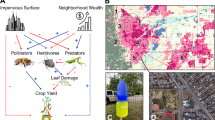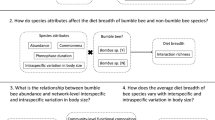Abstract
Leaf cutter ants are model organisms in studies of central place foraging, but these ants carry smaller than optimal leaf fragments for their body size. Laboratory experiments show that load ratios (leaf fragment mass/ant mass) are higher on extreme downhill trails than on extreme uphill trails, which could explain deviations from optimality in the wild. Here we examine how trail gradient affects load size selection in the field for the first time. We measured load ratios on extreme natural gradients in the mountains of Monteverde, Costa Rica. In general, load ratios were found to be higher on downhill trails than on uphill trails as found in laboratory studies. Not all colonies showed this pattern, indicating that other factors may interact with trail gradient to determine load size selection. The results confirm that extreme trail gradients can contribute to determine optimal load sizes in central place foraging in natural conditions.


Similar content being viewed by others
References
Adler FR, Gordon DM (2003) Optimization, conflict, and nonoverlapping foraging ranges in ants. Am Nat 162:529–543
Alma AM, Farji-Brener AG, Elizalde L (2017) A breath of fresh air in foraging theory: the importance of wind for food size selection in a central-place forager. Am Nat 190:410–419
Bryant DM, Turner AK (1982) Central place foraging by swallows (Hirundinidae): the question of load size. Anim Behav 30:845–856
Burd M (1995) Variable load size-ant size matching in leaf-cutting ants, Atta colombica (Hymenoptera: Formicidae). J Insect Behav 8:715–722
Burd M (1996) Foraging performance by Atta colombica, a leaf-cutting ant. Am Nat 148:597–612
Burd M (2001) Leaf tissue transport as a function of loading ratio in the leaf-cutting ant Atta cephalotes. Ecol Entomol 26:551–556
Burd M, Howard JJ (2005) Central-place foraging continues beyond the nest entrance: the underground performance of leaf-cutting ants. Anim Behav 70:737–744
Dussutour A, Deneubourg J-L, Beshers S, Fourcassié V (2008) Individual and collective problem-solving in a foraging context in the leaf-cutting ant Atta colombica. Anim Cogn 12:21
Farji-Brener AG, Chinchilla FA, Rifkin S et al (2011) The ‘truck-driver’ effect in leaf-cutting ants: how individual load influences the walking speed of nest-mates. Physiol Entomol 36:128–134
Fox J, Weisberg S, Price B, et al (2011) An R companion to applied regression
Freeman BM, Chaves-Campos J (2016) Branch width and height influence the incorporation of branches into foraging trails and travel speed in leafcutter ants Atta cephalotes (L.) (Hymenoptera: Formicidae). Neotrop Entomol
Haber WA (2000) Plants and vegetation. In: Nadkarni N, Wheelwright N (eds) Monteverde, ecology and conservation of a tropical cloud forest. Oxford University Press, New York, pp 39–94
Holder K, Polis GA (1987) Optimal and central-place foraging theory applied to a desert harvester ant, Pogonomyrmex californicus. Oecologia 72:440–448
Hölldobler B, Wilson EO (1990) The ants. Harvard University Press
Holway DA, Case TJ (2000) Mechanisms of dispersed central-place foraging in polydomous colonies of the argentine ant. Anim Behav 59:433–441
Houston AI, McNamara JM (1985) A general theory of central place foraging for single-prey loaders. Theor Popul Biol 28:233–262
Huntly NJ, Smith AT, Ivins BL (1986) Foraging behavior of the pika (Ochotona princeps), with comparisons of grazing versus haying. J Mammal 67:139–148
Jenkins SH (1980) A size-distance relation in food selection by beavers. Ecology 61:740–746
Kacelnik A (1984) Central place foraging in starlings (Sturnus vulgaris). I. Patch residence time. J Anim Ecol 53:283–299
Kacelnik A (1993) Leaf-cutting ants tease optimal foraging theorists. Trends Ecol Evol 8:346–348
Lenth R, Singmann H, Love J, et al (2018) Emmeans: estimated marginal means, aka least-squares means
Lewis OT, Martin M, Czaczkes TJ (2008) Effects of trail gradient on leaf tissue transport and load size selection in leaf-cutter ants. Behav Ecol 19:805–809
Longino JT (2000) The ants of Monteverde. In: Monteverde: ecology and conservation of a tropical cloud forest. Oxford University Press, New York, pp 132–136
McAleer K, Giraldeau L-A (2006) Testing central place foraging in eastern chipmunks, Tamias striatus, by altering loading functions. Anim Behav 71:1447–1453
Mueller UG, Mikheyev AS, Hong E et al (2011) Evolution of cold-tolerant fungal symbionts permits winter fungiculture by leafcutter ants at the northern frontier of a tropical ant–fungus symbiosis. Proc Natl Acad Sci 108:4053–4056
Norton V, Stevens-Wood B, Harris WE (2014) Flexibility of individual load-mass selection in relation to foraging trail gradient in the leaf-cutter ant Acromyrmex octospinosus. J Insect Behav 27:370–384
Olsson O, Brown JS, Helf KL (2008) A guide to central place effects in foraging. Theor Popul Biol 74:22–33
Orians GH, Pearson NE (1979) On the theory of central place foraging. In: Horn DJ, Mitchell RD, Stairs GR (eds) Analysis of ecological systems. Ohio State University Press, Columbus, pp 157–177
Pinheiro J, Bates D, DebRoy S, et al (2018) Nlme: linear and nonlinear mixed effects models
R Core Team (2018) R: a language and environment for statistical computing. R foundation for statistical computing
Roces F (1990) Leaf-cutting ants cut fragment sizes in relation to the distance from the nest. Anim Behav 40:1181–1183
Roces F, Núñez JA (1993) Information about food quality influences load-size selection in recruited leaf-cutting ants. Anim Behav 45:135–143
Rockwood LL, Hubbell SP (1987) Host-plant selection, diet diversity, and optimal foraging in a tropical leafcutting ant. Oecologia 74:55–61
Rozen-Rechels D, van Beest FM, Richard E et al (2015) Density-dependent, central-place foraging in a grazing herbivore: competition and tradeoffs in time allocation near water. Oikos 124:1142–1150
Rudolph SG, Loudon C (1986) Load size selection by foraging leaf-cutter ants (Atta cephalotes). Ecol Entomol 11:401–410
Schoener TW (1979) Generality of the size-distance relation in models of optimal feeding. Am Nat 114:902–914
Shrader AM, Kerley GIH, Brown JS, Kotler BP (2012) Patch use in free-ranging goats: does a large mammalian herbivore forage like other central place foragers? Ethology 118:967–974
Shutler D, Mullie A (1991) Size-related foraging behaviour of the leaf-cutting ant Atta colombica. Can J Zool 69:1530–1533
Tamm S (1989) Importance of energy costs in central place foraging by hummingbirds. Ecology 70:195–205
Traniello JFA (1989) Foraging strategies of ants. Annu Rev Entomol 34:191–210
Vilela EF, Jaffé K, Howse PE (1987) Orientation in leaf-cutting ants (Formicidae: Attini). Anim Behav 35:1443–1453
Wirth R, Beyschlag W, Ryel RJ, Hölldobler B (1997) Annual foraging of the leaf-cutting ant Atta colombica in a semideciduous rain forest in Panama. J Trop Ecol 13:741–757
Acknowledgements
We thank Orlando Torres, Jorge Torres, Myriam Scally, the Green Tree B and B and the Calandria Reserve for letting us sample on their property. This study is a result of the CIEE Study Abroad Program in Tropical Ecology and Conservation in Monteverde, Costa Rica. We thank the Costa Rican National Conservation System for allowing us permission to conduct research in Costa Rica (permit number M-P-SINAC-PNI-ACAT-021-2018).
Author information
Authors and Affiliations
Corresponding author
Ethics declarations
Conflict of Interest
The authors declare that they have no conflict of interest.
Additional information
Publisher’s note
Springer Nature remains neutral with regard to jurisdictional claims in published maps and institutional affiliations.
Rights and permissions
About this article
Cite this article
Finger, C., Chaves-Campos, J. Trail Gradient Influences Load Size in Wild Leaf Cutter Ants. J Insect Behav 33, 7–13 (2020). https://doi.org/10.1007/s10905-020-09740-2
Received:
Revised:
Accepted:
Published:
Issue Date:
DOI: https://doi.org/10.1007/s10905-020-09740-2




